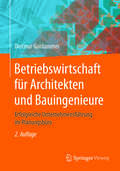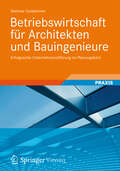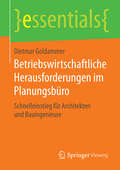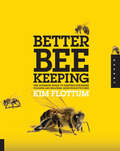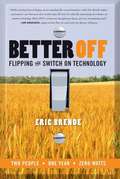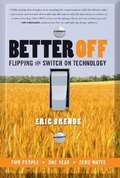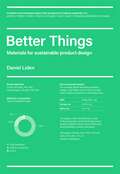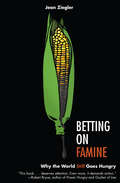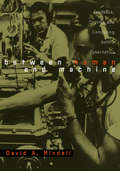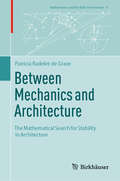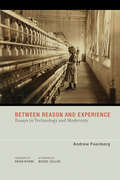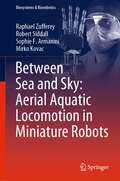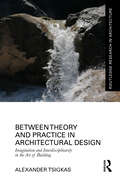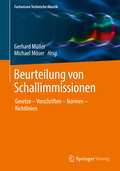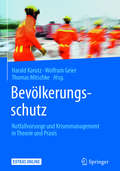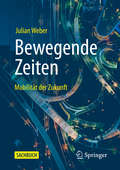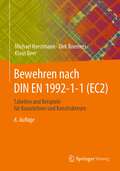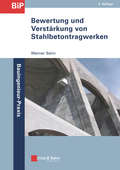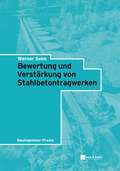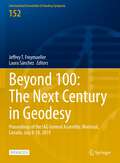- Table View
- List View
Betriebswirtschaft für Architekten und Bauingenieure
by Dietmar GoldammerDieses Fachbuch vermittelt das Basiswissen der Betriebswirtschaft und befähigt den Planer, die angemessenen Rahmenbedingungen für sein Unternehmen zu schaffen, erfolgreich zu kommunizieren, Mitarbeiter zu führen, Chancen und Risiken zu erkennen, die Profitabilität zu messen und zu lenken und so den langfristigen wirtschaftlichen Erfolg seines Büros sicherzustellen.
Betriebswirtschaft für Architekten und Bauingenieure: Erfolgreiche Unternehmensführung im Planungsbüro
by Dietmar GoldammerFür die erfolgreiche Führung eines Planungsbüros reicht es nicht aus, technisch perfekt zu sein. Architekten und Ingenieure in leitenden Positionen müssen auch die Verantwortung für den wirtschaftlichen Erfolg von Projekten übernehmen. Dazu ist es unerlässlich, dass sie die betriebswirtschafltichen Zusammenhänge kennen und Methoden und Werkzeuge zur Steuerung anwenden können. Diese Fachbuch vermittelt das Basiswissen der Betriebswirtschaft und befähigt den Planer, die angemessenen Rahmenbedingungen für sein Unternehmen zu schaffen, die Profitabilität zu messen und zu lenken und so den langfristigen finanziellen Erfolg seines Büros sicherzustellen.
Betriebswirtschaftliche Herausforderungen im Planungsbüro: Schnelleinstieg für Architekten und Bauingenieure (essentials)
by Dietmar GoldammerDietmarGoldammer zeigt wie sich Architektur- und Ingenieurbüros auf veränderteArbeitswelten, soziale Verantwortung und Nachhaltigkeit als neueHerausforderungen einstellen müssen. Der Autor beschreibt Frühwarnsysteme,Zertifizierungen und neue Organisationsformen, die dabei helfen. Erthematisiert auch, wie die Regelung der Nachfolge des Unternehmers ausgestaltetwerden kann. So zeigt sich: Der gesellschaftliche Wandel ist auch in denPlanungsbüros angekommen. Es wäre ein Leichtsinn zu glauben, dass dort alles soweiter geht wie bisher. Das Essential hilft kurz und prägnant, die richtigenSchritte anzustoßen.
Better Beekeeping: The Ultimate Guide to Keeping Stronger Colonies and Healthier, More Productive Bees
by Kim Flottum“The most lucid call to action ever written about land-based beekeeping” from the author of The Backyard Beekeeper (Tammy Horn, author of Bees in America and Beeconomy).Backyard beekeepers everywhere agree: a successful colony is a thing of beauty.Thousands of beekeepers have started beekeeping thanks to Kim Flottum’s first book, The Backyard Beekeeper, and they have added to their repertoire of skills with The Backyard Beekeeper’s Honey Handbook. Now, Better Beekeeping answers the question, “What do I do now that I’m a beekeeper?” This book takes serious beekeepers past the beginning stages and learning curves and offers solutions and rewards for keeping bees a better way. Better queens, better winters, better food, and better bees await any beekeeper willing to take on the challenge of having the right number of bees, of the right age, in the right place, in the right condition, at the right time.“There are numerous beekeeping books on the shelves that instruct on ‘how to,’ but Better Beekeeping is a book that explores ‘why to,’ which is essential for this ever-changing world of beekeeping today.” —Jennifer Berry, research coordinator at the University of Georgia’s Honey Bee Research Lab, commercial queen, and columnist for Bee Culture magazine
Better Off
by Eric BrendeWhat happens when a graduate of MIT, the bastion of technological advancement, and his bride move to a community so primitive in its technology that even Amish groups consider it antiquated? Eric Brende conceives a real-life experiment: to see if, in fact, all our cell phones, wide-screen TVs, and SUVs have made life easier and better -- or whether life would be preferable without them. By turns, the query narrows down to a single question: What is the least we need to achieve the most? With this in mind, the Brendes ditch their car, electric stove, refrigerator, running water, and everything else motorized or "hooked to the grid" and begin an eighteen-month trial run -- one that dramatically changes the way they live, and proves entertaining and surprising to readers. Better OFF is a smart, often comedic, and always riveting book that also mingles scientific analysis with the human story, demonstrating how a world free of technological excess can shrink stress -- and waistlines -- and expand happiness, health, and leisure. Our notion that technophobes are backward gets turned on its head as the Brendes realize that the crucial technological decisions of their adopted Minimite community are made more soberly and deliberately than in the surrounding culture, and the result is greater -- not lesser -- mastery over the conditions of human existence.
Better Off: Flipping the Switch on Technology
by Eric BrendeIn this social experiment, author Brende and his wife live in a primitive and remote community and rid their lives of anything motorized or electric. Describes how the author feels that such a life can decrease stress and increase one's happiness and health.
Better Things: Materials for Sustainable Product Design
by Daniel LidenHow often have you seen a label on a product proclaiming it to be made from 'recycled material', 'bioplastic' or similar, without it giving any details of the concrete environmental benefits? What do these terms really mean? A drive for greater transparency and demonstrable environmental benefits is happening in product design, through emerging legislation and standards, and consumer demand for more sustainable products and unambiguous marketing. In Better Things: Materials for Sustainable Product Design, Daniel Liden seeks to tackle the lazy 'greenwashing' terminology we see every day, providing a guide for product designers, manufacturers and consumers wishing to make better and more informed decisions about materials. The book comprises six chapters devoted to material categories - plastics, textiles, metals, ceramics and glass, wood and paper - and a seventh chapter covering emerging sustainable technologies. Each chapter includes interviews with industry experts, as well as photos, diagrams, environmental impact data, general material properties and more.
Better Things: Materials for Sustainable Product Design
by Daniel LidenHow often have you seen a label on a product proclaiming it to be made from 'recycled material', 'bioplastic' or similar, without it giving any details of the concrete environmental benefits? What do these terms really mean? A drive for greater transparency and demonstrable environmental benefits is happening in product design, through emerging legislation and standards, and consumer demand for more sustainable products and unambiguous marketing. In Better Things: Materials for Sustainable Product Design, Daniel Liden seeks to tackle the lazy 'greenwashing' terminology we see every day, providing a guide for product designers, manufacturers and consumers wishing to make better and more informed decisions about materials. The book comprises six chapters devoted to material categories - plastics, textiles, metals, ceramics and glass, wood and paper - and a seventh chapter covering emerging sustainable technologies. Each chapter includes interviews with industry experts, as well as photos, diagrams, environmental impact data, general material properties and more.
Betting on Famine: Why the World Still Goes Hungry
by Jean Ziegler&“The seminal book on global poverty and hunger . . . How rapacious speculators and complicit bureaucrats are starving a billion people&” (Wenonah Hauter, executive director of Food & Water Watch and author of Foodopoly). Few people know that world hunger was very nearly eradicated in our lifetimes. In the past five years, however, widespread starvation has suddenly reappeared, and chronic hunger is a major issue on every continent. In an extensive investigation of this disturbing shift, Jean Ziegler—one of the world&’s leading food experts—lays out in clear and accessible terms the complex global causes of the new hunger crisis. Ziegler&’s wide-ranging and fascinating examination focuses on how the new sustainable revolution in energy production has diverted millions of acres of corn, soy, wheat, and other grain crops from food to fuel. The results, he shows, have been sudden and startling, with declining food reserves sending prices to record highs and a new global commodities market in ethanol and other biofuels gobbling up arable lands in nearly every continent on earth. Like Raj Patel&’s pioneering Stuffed and Starved, Betting on Famine will enlighten the millions of Americans concerned about the politics of food at home—and about the forces that prevent us from feeding the world&’s children. &“In this devastating book, [Ziegler] describes the horrors of food insecurity, the callousness of &‘crusaders of neoliberalism&’ who control food and land access, and the individuals and grassroots organizations fighting for subsistence farmers and the right to food.&” —Publishers Weekly (starred review) &“Passionate, well-researched, objective, and illuminating . . . When we close this book, indignant, we know that those who die of hunger are victims of money and power.&” —L&’Express
Between Human and Machine: Feedback, Control, and Computing before Cybernetics (Johns Hopkins Studies in the History of Technology)
by David A. MindellToday, we associate the relationship between feedback, control, and computing with Norbert Wiener's 1948 formulation of cybernetics. But the theoretical and practical foundations for cybernetics, control engineering, and digital computing were laid earlier, between the two world wars. In Between Human and Machine: Feedback, Control, and Computing before Cybernetics, David A. Mindell shows how the modern sciences of systems emerged from disparate engineering cultures and their convergence during World War II. Mindell examines four different arenas of control systems research in the United States between the world wars: naval fire control, the Sperry Gyroscope Company, the Bell Telephone Laboratories, and Vannevar Bush's laboratory at MIT. Each of these institutional sites had unique technical problems, organizational imperatives, and working environments, and each fostered a distinct engineering culture. Each also developed technologies to represent the world in a machine.At the beginning of World War II, President Roosevelt established the National Defense Research Committee, one division of which was devoted to control systems. Mindell shows how the NDRC brought together representatives from the four pre-war engineering cultures, and how its projects synthesized conceptions of control, communications, and computing. By the time Wiener articulated his vision, these ideas were already suffusing through engineering. They would profoundly influence the digital world. As a new way to conceptualize the history of computing, this book will be of great interest to historians of science, technology, and culture, as well as computer scientists and theorists. Between Human and Machine: Feedback, Control, and Computing before Cybernetics
Between Mechanics and Architecture: The Mathematical Search for Stability in Architecture (Mathematics and the Built Environment #8)
by Patricia Radelet-de GraveThis collection of essays reflects the author's decades-long dedication to studying the interplay between mechanics and architecture. It explores how advancements in mechanics have influenced architectural innovation and how the need for new architectural solutions has driven theoretical progress in engineering. By examining the historical roots of these fields, these essays provide a deep analysis of key developments. This interdisciplinary work will appeal to scholars, students, and anyone interested in the complex relationship between the theoretical and practical aspects of architecture and civil engineering.
Between Reason and Experience: Essays in Technology and Modernity (Inside Technology)
by Andrew FeenbergA leading philosopher of technology calls for the democratic coordination of technical rationality with everyday experience.The technologies, markets, and administrations of today's knowledge society are in crisis. We face recurring disasters in every domain: climate change, energy shortages, economic meltdown. The system is broken, despite everything the technocrats claim to know about science, technology, and economics. These problems are exacerbated by the fact that today powerful technologies have unforeseen effects that disrupt everyday life; the new masters of technology are not restrained by the lessons of experience, and accelerate change to the point where society is in constant turmoil. In Between Reason and Experience, leading philosopher of technology Andrew Feenberg makes a case for the interdependence of reason—scientific knowledge, technical rationality—and experience. Feenberg examines different aspects of the tangled relationship between technology and society from the perspective of critical theory of technology, an approach he has pioneered over the past twenty years. Feenberg points to two examples of democratic interventions into technology: the Internet (in which user initiative has influenced design) and the environmental movement (in which science coordinates with protest and policy). He examines methodological applications of critical theory of technology to the case of the French Minitel computing network and to the relationship between national culture and technology in Japan. Finally, Feenberg considers the philosophies of technology of Heidegger, Habermas, Latour, and Marcuse. The gradual extension of democracy into the technical sphere, Feenberg argues, is one of the great political transformations of our time.
Between Sea and Sky: Aerial Aquatic Locomotion in Miniature Robots (Biosystems & Biorobotics #29)
by Raphael Zufferey Robert Siddall Sophie F. Armanini Mirko KovacThis book reports on the state of the art in the field of aerial-aquatic locomotion, focusing on the main challenges concerning the translation of this important ability from nature to synthetic systems, and describing innovative engineering solutions that have been applied in practice by the authors at the Aerial Robotics Lab of Imperial College London. After a general introduction to aerial-aquatic locomotion in nature, and a summary of the most important engineering achievements, the book introduces readers to important physical and mathematical aspects of the multimodal locomotion problem. Besides the basic physics involved in aerial-aquatic locomotion, the role of different phenomena happening in fluids, or those due to structural mechanics effects or to power provision, are presented in depth, across a large dimension range, from millimeters to hundreds of meters. In turn, a practice-oriented discussion on the obstacles and opportunities of miniaturization, for both robots and animals is carried out. This is followed by applied engineering considerations, which describe relevant hardware considerations involved in propulsion, control, communication and fabrication. Different case studies are analyzed in detail, reporting on the latest research carried out by the authors, and covering topics such as propulsive aquatic escape, the challenging mechanics of water impact, and a hybrid sailing and flying aircraft. Offering extensive and timely information on the design, construction and operation of small-scale robots, and on multimodal locomotion, this book provides researchers, students and professionals with a comprehensive and timely reference guide to the topic of aerial-aquatic locomotion, and the relevant bioinspired approaches. It is also expected to inspire future research and foster a stronger multidisciplinary discussion in the field.
Between Theory and Practice in Architectural Design: Imagination and Interdisciplinarity in the Art of Building (Routledge Research in Architecture)
by Alexander TsigkasBetween Theory and Practice in Architectural Design: Imagination and Interdisciplinarity in the Art of Building examines the intersection of philosophy and practice in architecture, exploring life, viability, and interdisciplinary collaboration and offering practical design insights for all beings.This book highlights several key architectural features, including a philosophical exploration of life, a focus on creating organic spaces, and the use of the viable system model (VSM) for organisational resilience. Additionally, it emphasises interdisciplinary design thinking and introduces a platform for viable and agile AI-assisted design. The book provides practical case studies highlighting how theory and practice can be integrated into architectural projects, giving architects actionable insights for innovative, adaptive, and purposeful design. By utilising organic design principles and interdisciplinary collaboration, readers will gain a transformative understanding of architecture. The book encourages the application of the viable system model to enhance organisational viability while promoting flexibility and viability in design. Furthermore, architects are encouraged to use logic-based and object-oriented ontology (OOO)-based AI-assisted design approaches due to their ability to evaluate design scenarios quickly.This book will be of interest to architects, designers, and enthusiasts seeking a comprehensive understanding of architecture, and professionals in architectural enterprises looking to enhance organisational viability will find value. Interdisciplinary collaboration is emphasised throughout the book. Students and academics in architecture and related fields will also benefit from its philosophical exploration and practical insights.
Between Two Worlds: Memoirs of a Philosopher-Scientist (Springer Biographies)
by Mario BungeTo go through the pages of the Autobiography of Mario Bunge is to accompany him through dozens of countries and examine the intellectual, political, philosophical and scientific spheres of the last hundred years. It is an experience that oscillates between two different worlds: the different and the similar, the professional and the personal. It is an established fact that one of his great loves was, and still is, science. He has always been dedicated to scientific work, teaching, research, and training men and women in multiple disciplines. Life lessons fall like ripe fruit from this book, bringing us closer to a concept, a philosophical idea, a scientific digression, which had since been uncovered in numerous notes, articles or books. Bunge writes about the life experiences in this book with passion, naturalness and with a colloquial frankness, whether they be persecutions, banishment, imprisonment, successes, would-be losses, emotions, relationships, debates, impressions or opinions about people or things. In his pages we pass by the people with whom he shared a fruitful century of achievements and incredible depths of thought. Everything is remembered with sincerity and humor. This autobiography is, in truth, Bunge on Bunge, sharing everything that passes through the sieve of his memory, as he would say. Mario's many grandchildren are a testament to his proud standing as a family man, and at the age of 96 he gives us a book for everyone: for those who value the memories that hold the trauma of his life as well as for those who share his passion for science and culture. Also, perhaps, for some with whom he has had disagreements or controversy, for he still deserves recognition for being a staunch defender of his convictions.
Between Understanding and Trust: The Public, Science and Technology
by Meinolf Dierkes Claudia Von Grote'This is a welcome book. The issues of public understanding of science open many questions. What does "understanding" mean? How does understanding translate into attitudes towards science and trust in scientists? What is the role of the mass media? The essays in this book shed light on such questions bringing insights from several disciplines. They help to define a meaningful research agenda for the future. - Professor Dorothy Nelkin, New York University
Beurteilung von Schallimmissionen: Gesetze – Vorschriften – Normen – Richtlinien (Fachwissen Technische Akustik)
by Michael Möser Gerhard MüllerDieser Band der Reihe Fachwissen Technische Akustik beschreibt das Ausmaß von Lärmwirkungen mit Hilfe objektivierbarer Einflussfaktoren. Die behandelten Themen dienen dazu, Aussagen zu treffen, ob angestrebte Schutzziele, wie z.B. die Vermeidung erheblicher Belästigungen oder die Gewährleistung einer guten Sprachverständlichkeit, erreicht werden.
Bevel Gear: Fundamentals and Applications
by Jan KlingelnbergThis is the first book to offer a complete presentation of bevel gears. An expert team of authors highlights the areas of application for these machine elements and presents the geometrical features of bevel gears as well as the various gear cutting processes based on gear cutting theory. The aspect of three-dimensional gearing is assessed in detail in terms of flank design, load capacity and noise behavior. A representation of production processes with the required technologies provides a knowledge base on which sound decisions can be based. The authors offer a thorough introduction to the complex world of bevel gears and present the rapid advances of these machine elements in a detailed, comprehensible manner. This book addresses design engineers in mechanical engineering and vehicle manufacturing, as well as producers of bevel gears and students in mechanical engineering.
Beverage Quality and Safety
by Tammy Foster Purnendu C. VasavadaBased on an IFT short course, Beverage Quality and Safety offers information on the latest beverage industry trends related to products, processing, and packaging technologies - including new generation nutraceutical beverages. It also covers important regulatory issues, including federal regulations on HACCP. Among the topical issues it addresses
Bevölkerungsschutz: Notfallvorsorge und Krisenmanagement in Theorie und Praxis
by Harald Karutz Wolfram Geier Thomas MitschkeDieses interdisziplin#65533;re Lehrbuch und Nachschlagewerk gibt einen klar strukturierten, orientierenden #65533;berblick #65533;ber Aufgaben, Strukturen, Organisationen und Akteure in den unterschiedlichen Bereichen von Notfallvorsorge und Gefahrenabwehr. Thematisiert werden sowohl natur- und ingenieurwissenschaftliche als auch sozial- und humanwissenschaftliche Aspekte des Risiko- und Katastrophenmanagements, sodass der Bev#65533;lkerungsschutz in Deutschland als eine klassische Querschnittsaufgabe erscheint. Das Werk leistet einen wesentlichen Beitrag zur Entwicklung #65533;bergreifender Reflexions- und Entscheidungskompetenz f#65533;r Risiko- und Katastrophenmanager, Rettungs- und Sicherheitsingenieure, Emergency Practitioner, Fachberater, Einsatzleiter und weitere F#65533;hrungskr#65533;fte.
Bewegende Zeiten: Mobilität der Zukunft
by Julian WeberSitzen wir wirklich schon bald nicht mehr selbst am Steuer unseres Autos, sondern werden nur noch von fahrerlosen Elektro-Taxis ans Ziel gebracht? Sollen Städte Car Sharing einführen? Welche Rolle werden Elektroroller, Seilbahnen oder manntragende Drohnen in den Mobilitätssystemen der Großstädte spielen? Dieses Buch erklärt endlich allgemeinverständlich, was sich hinter Schlagworten wie Elektromobilität, autonomes Fahren, Digitalisierung und Mobilitätsdienstleistungen wie Car Sharing oder Ride Hailing wirklich verbirgt, wie weit fortgeschritten diese Technologien heute sind, und vor allem auch in welchen Beziehungen und Abhängigkeiten diese zueinander stehen. Dabei werden neben den technischen auch die gesetzgeberischen und gesellschaftlichen Trends betrachtet, die als wichtige Rahmenbedingungen die Mobilität der Zukunft maßgeblich mitbestimmen.Aus dem Inhalt• Mobilitätsbedarfe: Wer will alles wann, warum wohin – und wie wird sich das in Zukunft ändern?• Technologische Trends: Elektromobilität, Digitalisierung, Autonomes Fahren – was werden die Fahrzeuge der Zukunft können?• Car Sharing, Ride Hailing, E-Scooter oder doch öffentlicher Nahverkehr: Welche Alternativen zum eigenen Pkw wird es in Zukunft geben?• Politik und Gesellschaft: Wie werden sich die Rahmenbedingungen der Mobilität in Zukunft entwickeln?• Mobilität im Wandel: Was sollten wir tun, um uns auf die Zukunft vorzubereiten?
Bewehren nach DIN EN 1992-1-1 (EC2): Tabellen und Beispiele für Bauzeichner und Konstrukteure
by Klaus Beer Michael Horstmann Dirk RoemersDieses Fachbuch bietet einen schnellen und übersichtlichen Einblick in die Bewehrung von baupraktisch häufig verwendeten Stahlbetonbauteilen. Wie viele Stabstähle kommen in einen Balken? In welche Richtung wird eine Q-Matte verlegt? Die Autoren erklären mit verständlichem Text und anschaulichen Abbildungen, nach welchen Regeln der Betonstahl im Beton verlegt und wie er zeichnerisch dargestellt wird. Zahlreiche Tabellen und Beispiele ermöglichen schnelle Hilfe bei der Erstellung eigener Bewehrungszeichnungen. Dieses Buch ist somit besonders für Bauzeichner und Konstrukteure, aber auch für (Jung)Ingenieure geeignet und bietet zuverlässige Hilfe in Ausbildung und Praxis. In dieser 8. Auflage wurde die Struktur des Buches stringenter gestaltet. Die zahlreichen Bewehrungsbeispiele wurden überarbeitet und auf den aktuellen Stand des EC2 und der zugehörigen DAfStb-Hefte gebracht. Zusätzlich wird das Kapitel WU-Betonbauwerke vertieft dargestellt.
Bewertung und Verstärkung von Stahlbetontragwerken (Bauingenieur-Praxis)
by Werner SeimDer Umgang mit vorhandener Bausubstanz gehört zu den täglichen Aufgaben für Bauingenieure und Architekten. Das vorliegende Buch vermittelt die notwendigen Kenntnisse der verschiedenen Methoden der Zustandserfassung und Bewertung von Bauteilen und Tragwerk sowie der Planung von Instandsetzungs- und Ertüchtigungsmaßnahmen. Ein Überblick über die Entwicklung der Bemessungsregeln und Materialkennwerte im Stahlbetonbau hilft bei der Auswertung von Bestandsunterlagen. Zahlreiche anschauliche Beispiele machen das Buch zu einem unverzichtbaren Leitfaden für die Planung und zu einem wertvollen Begleiter für das Studium. Für die zweite Auflage wurden die Inhalte mit Bezug zu den gültigen technischen Regelwerken vollständig aktualisiert. Darüber hinaus wurden einige Teile zum besseren Verständnis vollständig überarbeitet und neue Abschnitte aufgenommen.
Bewertung und Verstärkung von Stahlbetontragwerken (Bauingenieur-Praxis)
by Werner SeimStrengthening of existing structures is an increasing area of work for practising structural design engineers. The book delivers the necessary knowledge about various methods of recording the condition of existing elements and structures and the design of strengthening measures.
Beyond 100: Proceedings of the IAG General Assembly, Montreal, Canada, July 8-18, 2019 (International Association of Geodesy Symposia #152)
by Jeffrey T. Freymueller Laura SánchezThis open access book contains 30 peer-reviewed papers based on presentations at the 27th General Assembly of the International Union of Geodesy and Geophysics (IUGG). The meeting was held from July 8 to 18, 2019 in Montreal, Canada, with the theme being the celebration of the centennial of the establishment of the IUGG. The centennial was also a good opportunity to look forward to the next century, as reflected in the title of this volume. The papers in this volume represent a cross-section of present activity in geodesy, and highlight the future directions in the field as we begin the second century of the IUGG. During the meeting, the International Association of Geodesy (IAG) organized one Union Symposium, 6 IAG Symposia, 7 Joint Symposia with other associations, and 20 business meetings. In addition, IAG co-sponsored 8 Union Symposia and 15 Joint Symposia. In total, 3952 participants registered, 437 of them with IAG priority. In total, there were 234 symposia and 18 Workshops with 4580 presentations, of which 469 were in IAG-associated symposia.
